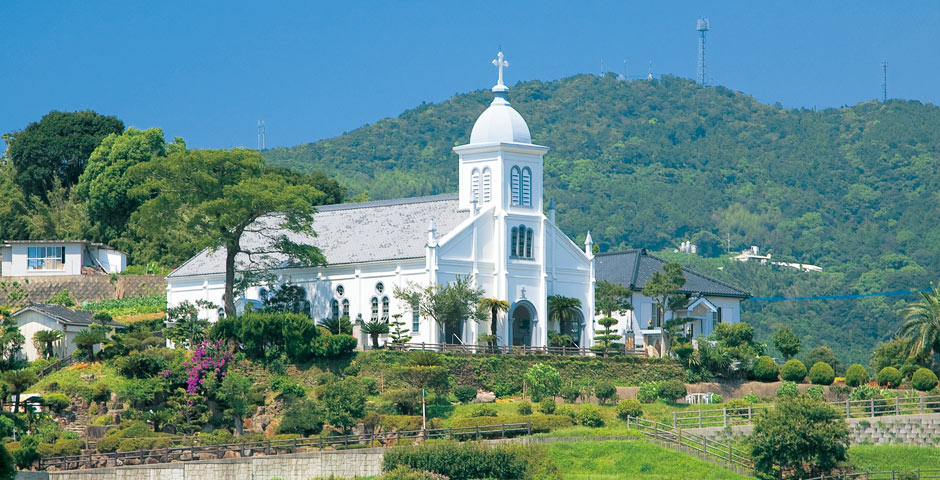
Romanesque Oe Catholic Church stands on a hilltop

Romanesque Oe Catholic Church stands on a hilltop
A new western European culture is introduced together with Christianity.
A Catholic seminary ? the "Collegio" - opens in Amakusa and the Christian population is estimated at 250,000 in the islands.
 Crop failurCrop failures are devastating on a national scale. Famine and starvation sweep Amakusa. Taxes are maintained at cripplingly high levels and the persecution of Christians continues. The people of Amakusa are in desperate straits.
Crop failurCrop failures are devastating on a national scale. Famine and starvation sweep Amakusa. Taxes are maintained at cripplingly high levels and the persecution of Christians continues. The people of Amakusa are in desperate straits.
Discontent breaks into protest over the ruinous taxes and ban on Christianity. People turn to Amakusa Shiro for leadership and the Rebellion of Amakusa and Shimabara takes hold of the region.
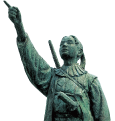
Amakusa Shiro, famous as the unifying force of the Rebellion, was named commander of the rebels when he was only 16 years of age. As a young, handsome and rather mysterious figure, Amakusa Shiro has left many stories and legends still repeated today.
-1639 The Edo Government issues Japan's Isolation Policy #5.
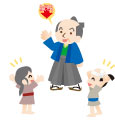 Suzuki Shigenari makes great contributions to restoring the region after the devastations brought during and after the rebellion. He also commissions the building of temples and shrines to bring peace to hearts of the people. He demonstrates his dedication to the people by halving his salary which is paid in local rice. Though a representative of the Shogunate, he advocates on behalf of the local population despite dangers to himself. When his son takes over after his death, his request for a reduced salary is granted.
Suzuki Shigenari makes great contributions to restoring the region after the devastations brought during and after the rebellion. He also commissions the building of temples and shrines to bring peace to hearts of the people. He demonstrates his dedication to the people by halving his salary which is paid in local rice. Though a representative of the Shogunate, he advocates on behalf of the local population despite dangers to himself. When his son takes over after his death, his request for a reduced salary is granted.
 A group of famous writers, Yosano Hiroshi (Tekkan), Kitahara Hakushu, Kinoshita Mokutaro, Yoshii Isamu, and Hirano Banri travel through Kyushu primarily to visit sites of Christian culture. They meet Fr. Garnier and, impressed by the Christian history, exotic environment, and beautiful natural environment of Amakusa, they collectively publish their journals of this trip entitled "Five Pairs of Shoes". Their experiences during this trip greatly influences their literary activities and gives birth to a style referred to as Southern European (literally Southern Barbarian). A new wind of creativity blows through Japanese literature.
A group of famous writers, Yosano Hiroshi (Tekkan), Kitahara Hakushu, Kinoshita Mokutaro, Yoshii Isamu, and Hirano Banri travel through Kyushu primarily to visit sites of Christian culture. They meet Fr. Garnier and, impressed by the Christian history, exotic environment, and beautiful natural environment of Amakusa, they collectively publish their journals of this trip entitled "Five Pairs of Shoes". Their experiences during this trip greatly influences their literary activities and gives birth to a style referred to as Southern European (literally Southern Barbarian). A new wind of creativity blows through Japanese literature.

Under the Edo-era government, the oppression of Christianity and the perUnder the Edo-era government, the oppression of Christianity and the persecution of Christians became increasingly severe. With the Meiji Era, however, freedom of religion was officially recognized and Christians of Hidden Faith began to reveal themselves. Today, the churches of Oe and Sakitsu are cherished as symbols of spirituality and fortitude.

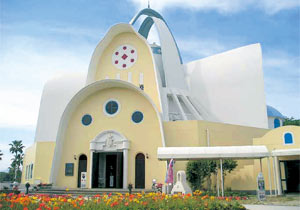
The historical background of the Rebels of Amakusa-Shimabara as well as the influence of European culture is introduced through exhibits and a powerful 3-D film show using state-of-the-art visual technology.

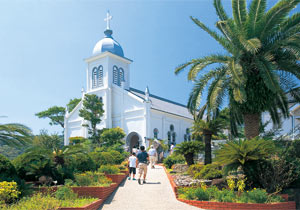
Oe Catholic Church was one of the first churches built after the ban on Christianity was lifted. The present church building was built in 1933 though the concerted effort of local parishioners and Fr. Garnier from France who dedicated his life to the spreading of the Gospel message.
* Mass is held on Sunday mornings, please refrain from sightseeing at this time.
* A church is place of prayer. Please keep a respectful manner in the church.
* Use address based GPS navigation for the church.

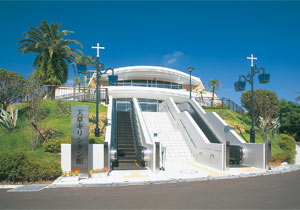
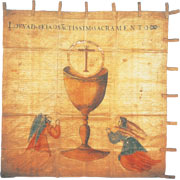
On the hilltop of Shiroyama Park near the Mound of 1000 Martyrs (killed during the rebellion) and other Christian graves, the Amakusa Christian Heritage Hall reopened in July 2010. Overlooking the center of Hondo City, the hall houses four display zones of which tell the story of local Christian history with particular focus on the Amakusa-Shimabara Rebellion. On display is the camp flag of Amakusa Shiro - designated as a National Important Cultural Property.
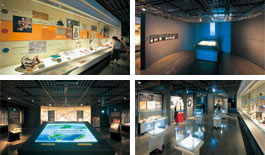
* 20% discount for groups of 20 or more